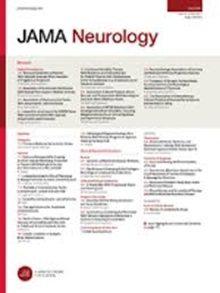Five-Year Outcomes from Deep Brain Stimulation of the Subthalamic Nucleus for Parkinson Disease.
IF 21.3
1区 医学
Q1 CLINICAL NEUROLOGY
引用次数: 0
Abstract
Importance The Implantable Neurostimulator for the Treatment of Parkinson's Disease (INTREPID) trial was a randomized, double-blind, sham-controlled study of subthalamic nucleus (STN) deep brain stimulation (DBS) for the treatment of Parkinson disease (PD). Objective To evaluate the long-term (5-year) outcomes and safety of STN-DBS for PD. Design, Setting, and Participants This was a prospective, randomized (3:1), 12-week double-blind sham-controlled study at 23 movement disorder centers across the US with an open-label 5-year follow-up. Patients were implanted and followed up with the Vercise DBS system from May 2013 to December 2022. Eligibility required diagnosis of bilateral idiopathic PD with more than 5 years of motor symptoms, more than 6 hours per day of poor motor function, modified Hoehn and Yahr Scale scores higher than 2, Unified Parkinson's Disease Rating Scale (UPDRS-III) score of 30 or higher (medication-off state), and 33% or higher improvement in UPDRS-III medication-on score. Intervention Bilateral STN-DBS for moderate to advanced PD. Main Outcomes and Measures Primary outcomes included changes in UPDRS and dyskinesia scores, quality-of-life measures, and safety assessments. Exploratory analyses included medication reduction and DBS association with motor signs. Results A total of 313 patients were enrolled with 191 receiving the DBS system, and 137 participants (72%) completed the study. The study population had a mean (SD) age of 60 (7.9) years, with 139 (73%) male participants. Motor function without medication as measured by UPDRS-III improved from a mean (SD) of 42.8 (9.4) to 21.1 (10.6) at year 1 (51%; 95% CI, 49%-53%; P < .001) and 27.6 (11.6) at year 5 (36%; 95% CI, 33%-38%; P < .001). Activities of daily living without medication as measured by UPDRS-III improved from a mean (SD) of 20.6 (6.0) to 12.4 (6.1) at year 1 (41%; 95% CI, 38%-42%; P < .001) and 16.4 (6.5) at year 5 (22%; 95% CI, 18%-23%; P < .001). Dyskinesia scores decreased from 4.0 (5.1) to 1.0 (2.1) at year 1 (75%; 95% CI, 73%-75%; P < .001) and to 1.2 (2.1) at year 5 (70%; 95% CI, 63%-75%; P < .001). The levodopa equivalent dose was reduced by 28% at year 1, remaining stable at year 5 (28%; 95% CI, 26%-31%; P < .001). The most common serious adverse event was infection (9 participants). Ten deaths were reported, none related to the study. Conclusions and Relevance Although STN-DBS outcomes declined slightly, possibly due to the progressive nature of the disease, patients with PD sustained significant improvement in motor and activities of daily living scores, along with a stable reduction in anti-parkinsonian medication over the 5-year follow-up period.丘脑下核深部脑刺激治疗帕金森病的5年疗效
植入式神经刺激器治疗帕金森氏病(INTREPID)试验是一项随机、双盲、假对照的研究,目的是通过丘脑底核(STN)深部脑刺激(DBS)治疗帕金森氏病(PD)。目的评价STN-DBS治疗PD的长期(5年)疗效和安全性。设计、环境和参与者这是一项前瞻性、随机(3:1)、为期12周的双盲假对照研究,在美国23个运动障碍中心进行了为期5年的开放标签随访。患者于2013年5月至2022年12月植入并随访Vercise DBS系统。资格要求诊断为双侧特发PD,运动症状超过5年,每天运动功能不良超过6小时,改良Hoehn和Yahr量表评分高于2分,统一帕金森病评定量表(UPDRS-III)评分为30分或更高(停药状态),UPDRS-III用药评分改善33%或更高。干预:双侧STN-DBS治疗中晚期PD。主要结果和测量方法主要结果包括UPDRS和运动障碍评分的变化、生活质量测量和安全性评估。探索性分析包括药物减少和DBS与运动体征的关联。结果共纳入313例患者,其中191例接受了DBS系统,137例(72%)完成了研究。研究人群的平均(SD)年龄为60岁(7.9岁),其中139名(73%)男性参与者。UPDRS-III测量的无药运动功能在第1年从平均(SD) 42.8(9.4)改善到21.1 (10.6)(51%;95% CI, 49%-53%; P <。001)和27.6(11.6)在5年(36%;95%可信区间,33% -38%;P <措施)。UPDRS-III测量的无药日常生活活动在第1年从平均(SD) 20.6(6.0)改善到12.4 (6.1)(41%;95% CI, 38%-42%; P <。001)和16.4(6.5)在5年(22%;95%可信区间,18% -23%;P <措施)。运动障碍评分在第一年从4.0(5.1)下降到1.0 (2.1)(75%;95% CI, 73%-75%; P <。001)和1.2(2.1)在5年(70%;95%可信区间,63% -75%;P <措施)。左旋多巴等效剂量在第1年减少28%,在第5年保持稳定(28%;95% CI, 26%-31%; P < .001)。最常见的严重不良事件是感染(9名参与者)。报告了10例死亡,但都与该研究无关。结论和相关性尽管STN-DBS结果略有下降,可能是由于疾病的进行性,PD患者的运动和日常生活活动评分持续显着改善,同时抗帕金森药物治疗在5年随访期间稳定减少。
本文章由计算机程序翻译,如有差异,请以英文原文为准。
求助全文
约1分钟内获得全文
求助全文
来源期刊

JAMA neurology
CLINICAL NEUROLOGY-
CiteScore
41.90
自引率
1.70%
发文量
250
期刊介绍:
JAMA Neurology is an international peer-reviewed journal for physicians caring for people with neurologic disorders and those interested in the structure and function of the normal and diseased nervous system. The Archives of Neurology & Psychiatry began publication in 1919 and, in 1959, became 2 separate journals: Archives of Neurology and Archives of General Psychiatry. In 2013, their names changed to JAMA Neurology and JAMA Psychiatry, respectively. JAMA Neurology is a member of the JAMA Network, a consortium of peer-reviewed, general medical and specialty publications.
 求助内容:
求助内容: 应助结果提醒方式:
应助结果提醒方式:


